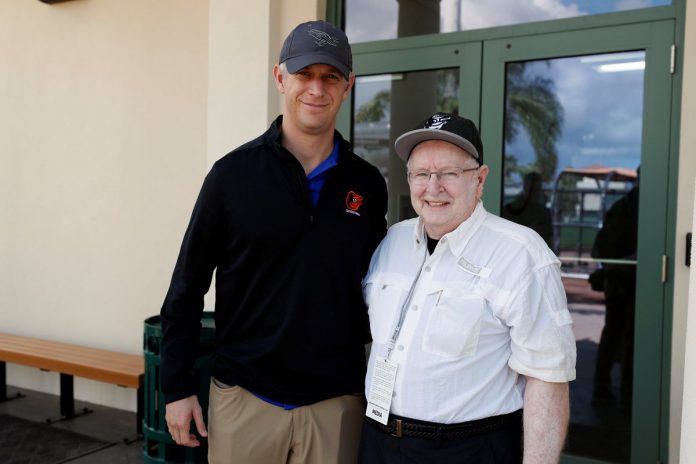By Doc Shorebird
With the introduction of Doppler radar instruments to baseball, new metrics have added to the understanding of the path of a pitched ball. A moving ball alters the frequency of the returned radar signal and is known as the Doppler Effect. The most common Doppler Radar instrument is use in baseball today is the Trackman. It became mandatory for all major league stadiums in 2015. The Orioles have used it for their minor league teams for a number of years now. I remember Orioles Director of Minor League Operations, Kent Qualls,explaining the system to me at the Minor League Complex at Twin Lakes in 2016. He said, “it gives us about 27 points of information, but we haven’t figured out what to do with all of them yet.” Well, they did know what to do with the spin data.
Because of this technology, it is now known that the more a 4-seam fastball spins, the more it moves and also gives the batter the false impression that it rises. This, of course, leads to more missed pitches by the batter. The older description that a pitcher has “late life” can now be better quantified. Using the spin metric helps teams select effective pitchers. Each type of pitch has a special relationship to spin rate (SR). A pitcher wants his 4-seamer to have a high SR, but not his sinker or knuckleball.
It’s been apparent for the last few years that the Orioles have needed a “Spin Doctor.” Once, the Orioles had a pitcher with one of the best SR in the majors in Koji Uehara. Uehara threw at 89 mph, but he had a SR of 2470 or so revolutions per minute (RPM) that resulted in an average of 10.8 strikeouts per 9 innings. That’s near the top of the range of 1800 to 2400 RPM for pitches near 90 MPH. I believe that the Astro’s Justin Verlander now has one of the highest SR with 2490 RPM on a 95 MPH 4-seam fastball. Verlander’s 4-seam is reported to have a vertical movement 11.2 inches. The Astro’s also added another high SR pitcher in Ryan Pressley. Hmm, Orioles Executive Vice-president and General Manager, Mike Elias, was the Assistant General Manager for the Astros.
In my opinion, location is the most important factor for a pitch. Velocity and spin are next in importance, but combining the latter two into a single factor, humorously called “Bauer Units” (but that’s another story). Bauer Units (BU) factor-in both velocity and SR. The spin-to-velocity ratio is what determines movement. Bauer Units are determined by dividing the SR (RPM) by the velocity (MPH). The new strategy for many pitchers now is to throw higher out of the upper-cut range with the deception that the ball is rising, because more batters have adjusted to the sinking fastball.
The ball’s spin interacts with its seams to create a pressure differential called the Magnus Effect. This pressure differential on a 4-seamer moves the ball more upwards than normal. No, it doesn’t actually make the ball rise and overcome the force of gravity, but it does produce a change in the normal path giving the perception of rising. The Magnus Effect on a curveball is to force it downwards and on a slider is to push it laterally. As Dylan Bundy told me the other day, the secret to Zack Britton’s sinker is to reduce the spin and take away the rise.
Unfortunately, the Orioles have dropped drastically in average SR for their pitchers. While the top teams have been increasing the average SR for their pitchers by about a full BU (RPM/MPH ratio) from 2015 to 2018, the Orioles have decreased 0.14 BU. They ranked 23 out of 30 during this time.
On the otherhand, the Astro’s rank 3rd in BU and have been at or near the top in increasing BU since 2015. (Source: Baseball Savant). Keep an eye on the Orioles average BU improvement during the next few years. Small improvements in BU can be made by pitchers (short of using sticky substances) by keeping their index and middle fingers in contact with the ball longer. However, to get the biggest improvement in average team BU requires acquiring pitchers already having excellent BU.
The old phrase was “like the way the ball comes out of his hand.” Now high-speed Edgertronic cameras shooting at 4456 frames per second can closely examine just how a ball comes out of a pitcher’s hand.
The Trackman does provide plenty of information. In the Minors, pitchers still chart pitch velocity and location, but they have also have two Trackman operators in the press box recording the Trackman information on a computer. I have set between them and watched the numbers on a screen. They can recall every pitch a pitcher has thrown for the season and read off the many numbers tracked… 27 in all counting the hit balls.
Another useful measurement obtained by the Trackman is “Tilt.” Tilt measures the spin direction of a pitch. According to the Trackman literature, Fastballs and changeups have a backspin. 4-seamers have a 12:00 tilt (straight backspin). Sinkers have a 2:00 tilt (more side-to-side movement). Breaking balls have top spin. A 12-to-6 curve has a 6:00 tilt (straight down). A 2-to-8 slider has a 8:00 tilt (more side-to-side movement). As an example, a pitch with a 1:00 tilt has a backspin spinning from 7:00 to 1:00 at the catcher.
Here’s a brief glossary of important terms used with the Trackman (from Trackman’s literature).
Pitch Velocity: Release speed of pitch in MPH when it leaves the pitcher’s hand.
Spin Rate: A primary indicator of swing and miss ability. The speed the ball is spinning as it leaves the pitcher’s hand in RPM.
Tilt: The direction the ball is spinning (displayed in clock format).
Extension:The distance from the tip of home plate at which the pitcher releases the ball.
Effective Velocity: The perceived speed of the pitch taking time of flight and extension into account.
Zone Velocity: The speed of the pitch as it crosses the frornt of home plate.
Release Height: The height above home plate at which the pitcher releases the ball.
Release Side: The distance from the center of the rubber at which the pitcher releases the ball.
Vertical Break: Distance between where the pitch actually crosses the front of home plate height-wise, and where it would have crossed home plate height-wise if had it traveled in a perfectly straight line from release, completely unaffected by gravity.
Horizonal Break: Distance between where the pitch actually crosses the front of home plate side-wise, and where it would have crossed home plate side-wise if had it traveled in a perfectly straight line from release.
There is also a lot of fun information that the Doppler Systems can provide about the hit ball as well, but that’s a story for another day.

























